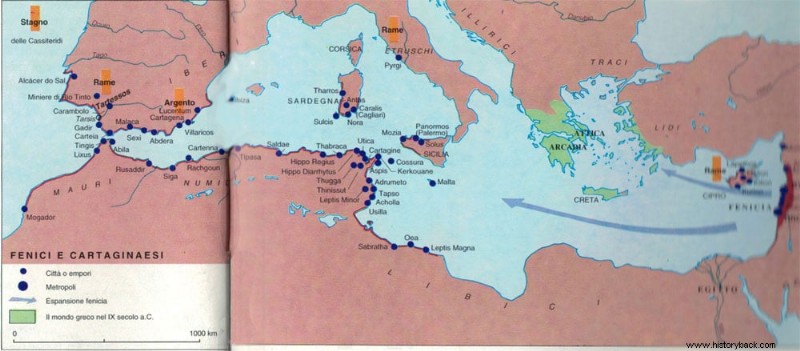Around 2000 BC , the Phoenicians they lived in the lands of present-day Lebanon and in a small part of Syria; later, they also occupied other territories along the coasts of the Mediterranean.
The Phoenicians they did not have a unitary state. In fact, their cities were independent, each with its own king and gods, but they had the same language and the same customs. The Phoenician civilization reached the period of greatest development between 1200 BC. and 500 BC

In Phenicia the cultivated land was scarce. The only natural wealth that the Phoenicians had was the wood of the forests: they built great ships with wood .
With the ships the Phoenicians went to look for raw materials in territories outside their country.
When they returned to their homeland they transformed the raw materials into goods and objects that they then resold to other peoples:the Phoenicians they became skilled craftsmen.
They produced very valuable objects, such as bronze cups and plates, combs, boxes and ivory furniture.
The Phoenicians produced glass and they have taken it all over the Mediterranean .
Another very famous and precious product manufactured by the Phoenicians were the fabrics colored with purple . The purple was extracted from a mollusk, the murex. Thousands of molluscs were needed to dye a single fabric. The resulting colors ranged from violet to deep red.
Probably the name Canaan it meant “ purple tincture ". Purple, as you already know, was a substance that dyed fabrics. However, we know and call this people “ Phoenicians ".
The ancient Greeks (another ancient people you will study next year) called them Phoinikes, which meant" people of the purple ".
One of the most important contributions of the Phoenicians to the history of Western culture was the alphabet. They are also credited with introducing the purple tint, called Tyrian purple, and the invention of glass. Their manufactures, in particular that of fabrics and dyes, metalworking and glass were very famous in the ancient world. Each Phoenician city was placed under the protection of a particular deity (Baal, "the Lord"), to whom the most important place of urban worship was dedicated. The Phoenicians , for their trades, they needed a simple and quick system to record the goods sold and bought.
The scripts known and used up to that time (the cuneiform and the hieroglyphics) were, in fact, very difficult to learn .
The Phoenicians have changed and simplified these scripts:
● they linked the sounds of the human voice to about twenty written signs;
● then they combined the signs to form words:thus they invented the alphabet.
The Phoenician alphabet was written from right to left.
The scribes wrote mainly on papyrus sheets, but not only:they also wrote on wood, leather, pieces of terracotta and metal sheets.
The Phoenicians spread the alphabet among the peoples with whom they had commercial relations. [
Not much is known about the history of Phoenician cities in the 10th century. XII-X a. C .:from Byblos speak the Egyptian tale of Wenamon and a series of local royal epigraphs.
Assyrian texts ( Tiglatpileser I) give news about Arwad and Phenicia northern.
The Old Testament speaks of the king of Tire Ḥīrām .
Already in the century. XI Phoenician navigation developed in the Mediterranean, in search of metals, towards Cyprus , Sardinia and Spain .
The dates of the Greek tradition for the foundation of the first "colonies" ( Cadiz 1110, Utica 1101) refer to these ancient merchant expeditions. The growing military pressure of Assyria (they became Assyrian provinces:in 743 the Phenicia northern with capital Sumura , in 677 the Phenicia central with the capital Sidon, in 671 the Phenicia southern with capital Usu) and the commercial and colonial development of the Greek cities persuaded the Phoenicians to move from merchant shipping with support points to the foundation of real settlements: Carthage ; Mozia , Palermo , Solunto (Sicily); Cagliari , Nora , Sulcis , Tharros (Sardinia); in southern Spain and the Balearics. The colonies became autonomous and organized themselves under the domination of Carthage.
The cities of Phenicia instead, after the harsh period of Assyrian and Babylonian domination, they recovered in the sec. VI-IV under the Persian Empire, interested in maintaining good relations to take advantage of the Phoenician fleet in the wars against the Greeks .
In the middle of the century. IV, however, the Greek commercial and cultural penetration in the East and symptoms of crisis in the Persian Empire led to revolts in the Phoenician cities, so that the expedition of Alexander the Great was welcomed (with the exception of Tire conquered in 333 BC) . With the inclusion in the Hellenistic kingdoms, Phenicia, exposed to the Greek economic, demographic and linguistic penetration, ceased to have an autonomous history.
The capital of papyrus paper
The ancient Egyptians invented papyrus paper.
But it was the Phoenicians to make it known to the peoples of antiquity.
Byblos was the Phoenician city where papyrus was traded.
The ancient Greeks they called biblo the papyrus rolls, named after the place they bought them from.
